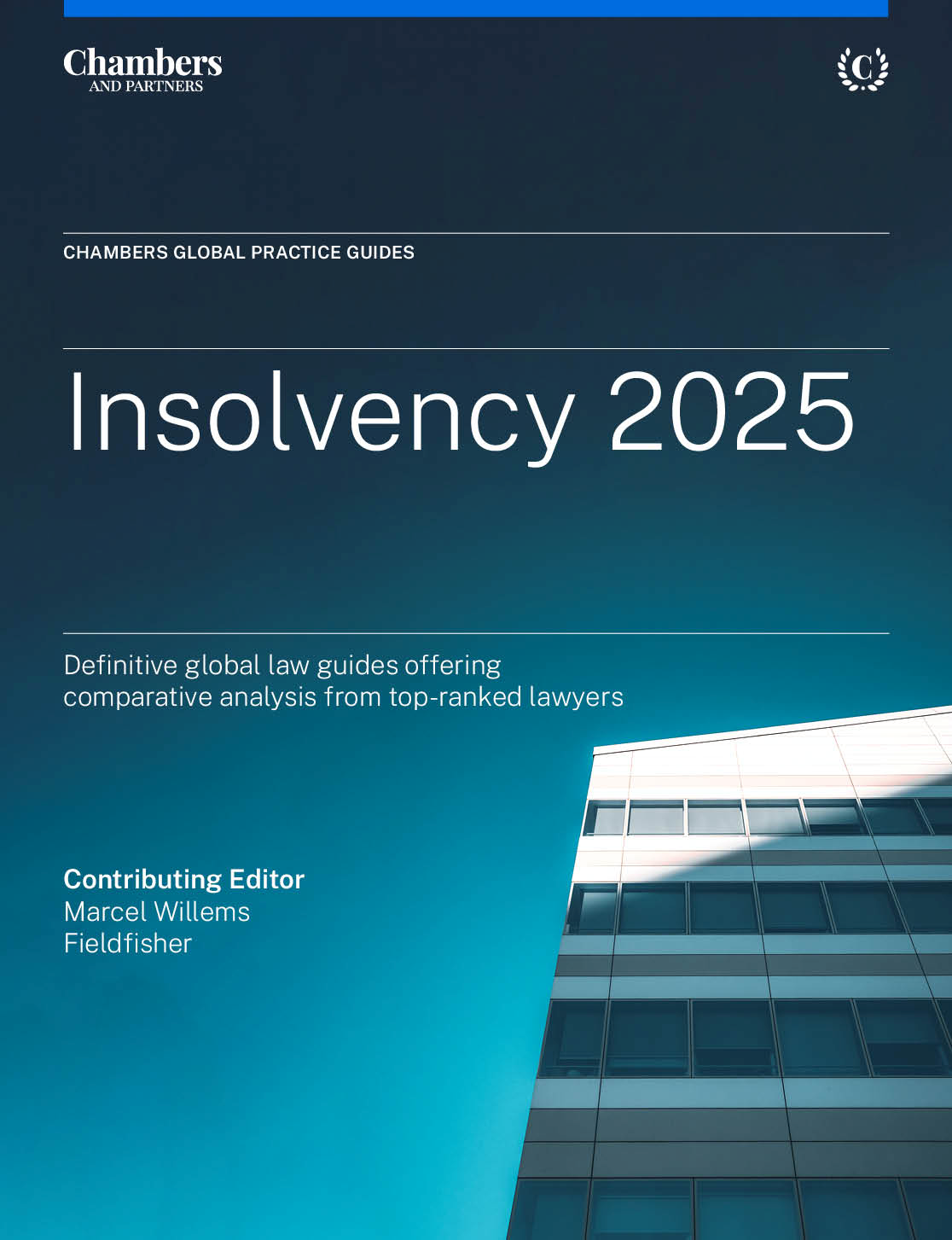
Insolvency 2025
The Insolvency 2025 guide features close to 30 jurisdictions. The guide provides the latest legal information on the broad legal framework for insolvencies, the role of creditors, out-of-court and statutory restructuring processes, statutory insolvency and liquidation procedures, cross-border insolvency issues, the duties and liabilities of directors and officers, claims to set aside or annul a transaction.
Last Updated: November 13, 2025
Compare law and practice by selecting locations and topic(s)
Select Locations

Select Topic(s)

Please select at least one location and one topic to use the compare functionality.
The Insolvency Guide 2025 aims to provide legal and non-legal professionals with a concise overview of the main restructuring and insolvency law topics in various jurisdictions. The experienced authors on restructuring and insolvency law describe the rules and practices applicable in their jurisdictions, as well as the latest (upcoming) developments. To provide an outline of the main elements, this Guide discusses the different liquidation, restructuring and insolvency procedures in each jurisdiction, as well as the main statutory officers and other actors within the systems.
Nowadays, many businesses are no longer operating in just one jurisdiction, so that liquidation, restructuring and insolvency procedures also must deal with cross-border businesses and aspects. Therefore, this Guide also considers how different jurisdictions deal with international aspects, such as recognition of foreign judgments, or co-operation between the various actors in the event of cross-border procedures. Furthermore, the Guide covers the obligations of directors and officers, and under which circumstances they can be held personally liable. Finally, the possibilities to set aside transactions that preceded a restructuring or insolvency procedure will be discussed.
The (national) rules and practices of insolvency law have been evolving for years, decades or centuries; at the same time there are developments that have come up only recently or have come from other legal systems or continents. Such developments always take place in a legal, political and socio-economic context. Some of the global developments and practices that came to the surface in 2025 will be discussed below.
Globalisation
Today’s economy faces constant change and uncertainties. Globalisation, technology and geopolitical shifts increase the interdependence of national economies. Globalisation offers companies new opportunities to prosper through cross-border trade, investment and collaboration. On the other hand, these developments can also lead to companies failing to survive, due to a lack of adaptability to change or a lack of financial resilience. Because of the interdependence of economies, financial problems or bankruptcies in one economy can have severe financial consequences for the other. For example, the ongoing insolvency proceedings regarding the Signa Group, which was part of a network of about a thousand companies. Around 40,000 people worldwide were employed in companies owned by the Signa Group, and those jobs were suddenly at risk.
The ongoing process of opening economic, political, technological and social borders is one of the most discussed phenomena of recent decades. Businesses today no longer operate only in the national market, but increasingly and more easily enter the international market with their goods or services. With customers, suppliers, employees, shareholders and other lenders spread across different continents, this presents companies with global growth opportunities. As the complexity of businesses increases, the complexity of the insolvency procedures that must be gone through if such a business is at risk of insolvency also increases.
A consequence of globalisation is that companies are specialising and exports are increasing. As a result, there is the increasing influence of the logistics sector. One consequence is that certain products are no longer produced domestically but must be imported from other countries. This therefore provides many opportunities for companies to operate efficiently and internationally but can also painfully expose how interdependent companies and economies have become. As demonstrated in March 2021, when a container ship blocked the Suez Canal and daily trade worth EUR9 billion came to a halt. On top of that, thousands of freight containers were shipped late, causing delays in manufacturing processes as factories received raw materials and assembling parts late, and for a long time the orderly spread of containers over the globe was disrupted. In addition, more recently, the worries in Europe that China may block or delay the supply of rare earth metals (a group of 17 elements that are essential for modern technologies and clean energy), thereby jeopardising innovative development in various branches, especially automotive.
Another consequence of technological globalisation is the increased competition from businesses that are not even required to be physically present in the same country. Technical developments mean that companies can offer their goods or services cheaper, faster and more efficiently. Companies that do not invest in technical innovations can run into declining revenues. Rapid technological developments such as automation and digital platforms are threatening traditional business models. Furthermore, artificial intelligence has become a structural force reshaping entire industries. While offering efficiency gains, it has also led to widespread job displacement and the collapse of outdated business models, particularly in retail, logistics and customer service. This is also reflected by the increasing bankruptcy rates in the respective industries.
Companies that do invest in the latest innovations become increasingly dependent on technology, with its own cyber risks. How dependent companies have become on IT was illustrated by one of the largest IT outages in history, in July 2024, which disrupted businesses and governments around the world. The disruption was caused by a flawed update to a cloud-based security software of a global top cybersecurity company. The update triggered a malfunction which made some 8.5 million Microsoft Windows devices crash, led to disruptions of airlines, banks, broadcasters, hospitals and cash machines globally, and is said to have cost over USD10 billion.
A last aspect of globalisation that should be mentioned here is cryptocurrency. This literally borderless way of making payments causes legislatures and the judiciary many challenges while they are trying to come to grips with it. The ease with which the trust of the investing public may be abused (FTX), the grave consequences of (the possibility of) hacks (Mount Gox) and the danger of money laundering and financing of terrorism with cryptocurrencies underline the need for caution, whereas at the same time cryptocurrencies offer a unique worldwide speculation mechanism without involvement of any financial institution or regulated exchange. And yet, despite the risks and the warnings for it, the US has proven a big backer of stablecoins with the GENIUS Act (the Guiding and Establishing National Innovation for US Stablecoins Act), which may well lead the EU to follow this example shortly so as to not lag behind and lose ground to the dollar.
Uncertain times
Other sources of uncertainty in the current juncture are geopolitical tensions and ESG. An example of the first is the ongoing war between Russia and Ukraine. Besides the human and political consequences, this war has a major impact on the global economy, in particular, for all countries that were dependent on Russia for energy. Rising energy prices and disruptions in the supply chain has meant that companies in energy-intensive sectors, such as industry and transport, saw their costs skyrocketing. In addition, non-Russian businesses were also affected by the sanctions imposed on Russian-(owned) businesses, for instance because of frozen assets. On the other hand, this war and the tensions that go with it have boosted especially the arms manufacturing industry globally. Beyond the war in Ukraine, escalating tensions in the Middle East further destabilised trade flows and energy routes and raised the risk of regional recessions.
ESG puts additional strain on companies in the form of, for instance, extra administrative burdens (checking compliance by the entire supply chain and reporting on measures taken) and the necessity to invest heavily in measures to safeguard the environment. Funding of such investments and, as a matter of fact, financing of operations in general, seems to be shifting strongly from the traditional banks to private institutions like hedge funds, private equity firms and business angels with entirely different approaches and requirements, adapting to which provides a challenge in itself.
Furthermore, trade restrictions are also a source of uncertainty. Whether they are of a protectionist nature (import duties) or aim at limiting national security risks (prohibition of the use of foreign software), such policies can have wide-reaching impacts on businesses and increase uncertainty across the board. In this context, what immediately stands out, in 2025, is the sweeping import tariffs introduced by the United States on key industrial and technological goods, triggering retaliatory measures and disrupting global supply chain developments which have increased insolvency risks for export-dependent businesses and added significant volatility to international trade. Due to unpredictable government behaviour, international trade is in a constant state of shock, with old alliances being broken and new ones being formed.
Sanctions, asset freezes and political instability have become common triggers for insolvency, particularly for businesses with cross-border operations or exposure to restricted markets.
Bankruptcy Numbers
Now in 2025, businesses are still facing relatively high inflation (due to, amongst others, trade protectionism and wage growth), higher interest rates and low unemployment. This, combined with the above-mentioned additional economic developments, has resulted in an increasing number of businesses struggling financially, and there has been a clear upward trend in the number of restructurings and bankruptcies, which is generally believed to continue for quite some time, yet at a slower pace. According to Allianz-Trade’s insolvency report, the insolvency numbers in 2024 stood out in the US with a rise of +22%, followed by the Eurozone with a rise of +19%.
The forecasts, as made by Allianz-Trade, imply that the global upward trend of business insolvencies will continue through 2026, with +6% in 2025 and +3% in 2026. The key drivers behind the upward trend are the risk of delayed easing of interest rates, the prolonged uncertain environment and the soft rebound in demand. Driving the global increase, North America and Asia will see the steepest gains: the US is forecast at an increase of +11% to 25,580 cases in 2025. Western Europe faces an increase of +3% in 2025, marking a fourth consecutive annual increase.
Insolvency Law
Within insolvency law, there is increasing demand for out-of-court restructuring and preventive measures that can rescue companies in financial distress from bankruptcy. In such proceedings, the emphasis is no longer just on settling debts, but also on preserving jobs and economic value that otherwise would be lost.
In light of the above developments, such as ever-increasing globalisation, and the growing presence of international aspects in restructuring or insolvency proceedings, additional international insolvency law rules are needed. This will allow for more predictable and efficient insolvency proceedings. To this end, a proposal was made by the European Commission in December 2022, which aims to harmonise certain aspects of insolvency law in the European Union, such as a director’s duty to request the opening of insolvency proceedings and a pre-pack procedure in which a (or part of a) business can be sold as a going concern. In 2025, the proposal progressed as the Council adopted its general approach, paving the way for negotiations with the European Parliament once it finalises its position, with the aim of agreeing on a final directive.
As long as insolvency law is not harmonised, knowledge of other legal systems is crucial.

